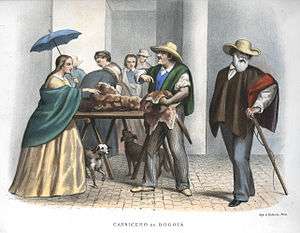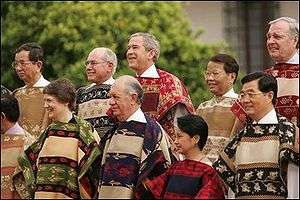Poncho
A poncho (Spanish pronunciation: [ˈpontʃo]; Quechua: punchu; Mapudungun: pontro; "blanket", "woolen fabric")[1][2][3] is an outer garment designed to keep the body warm. A rain poncho is made from a watertight material designed to keep the body dry from the rain. Ponchos have been used by the Native American peoples of the Andes since pre-Hispanic time, from places now under the territory of Ecuador, Colombia, Bolivia, Argentina, Chile and Peru and are now considered typical South American garments.


In late 18th century Basque navigator José de Moraleda wrote that the ponchos of the Huilliche of Osorno were less pleasing ("vistosos") than those of Chiloé Archipelago.[4] The Huilliche are the principal indigenous population of Chile from Toltén River to Chiloé Archipelago.[5] Mapuche ponchos were once highly valued, in the 19th century a poncho could be traded for several horses or up to seventy kilos of yerba mate.[6] 19th century Mapuche ponchos were clearly superior to non-indigenous Chilean textiles and of good quality when comparing to contemporary European wool textiles.[6]
Types of ponchos
In its simplest form the poncho is essentially a single large sheet of fabric with an opening in the center, for the head, and often it has an extra piece of fabric serving as a hood. Rainproof ponchos normally are fitted with fasteners to close the sides once the poncho is draped over the body, with openings provided for the arms; many have hoods attached to ward off wind and rain.
Alternative ponchos are now designed as fashion items.[7] They are the same shape but of different material. They are designed to look fashionable and provide warmth while remaining breathable and comfortable, rather than to ward off wind and rain. These are often made out of wool or yarn, knitted or crocheted. Ponchos with festive designs or colors can be worn at special events as well.
Traditional ponchos
The poncho was one of the typical clothes of many cultures of South America. Although investigations have concluded that Ponchos' origins could be Ecuador or Peru, there is not exact evidence where was fabricated the first Poncho.[8] Nowadays the poncho is commonly associated with the Americas. As traditional clothing, the local names and variants are:
- Ruana, in cold regions of Colombia.
- Poncho, most of Spanish-speaking countries and worldwide.
- Pala or Poncho, in Portuguese-speaking Brazil (mainly in the South).
- Chamanto, only in Central Chile, poncho in the north and south.
- Jorongo, usually larger or full-length, and often used for special occasions or horse-back riding.
- Gabán, typical in Michoacán, Mexico.
- Poncho chilote, a heavy woolen poncho of Chiloé Archipelago.
Military ponchos
The poncho was first used on a regular basis in the 1850s for irregular U.S. military forces operating on the U.S. Western Plains.[9] These early military ponchos were made of gutta percha muslin, a latex-coated, waterproof cloth.[10] Ponchos made of gutta-percha or India rubber coated cloth were officially adopted during the American Civil War, both as rain clothing and as a ground sheet for sleeping. While originally intended for cavalry forces, they were widely used by infantry as well; General Sherman's Union troops, lightly equipped and living off procurement demand from the local populace, wore ponchos during wet weather encountered during the march through Confederate Georgia to the sea.[10]
Discontinued after the Civil War, the U.S. Army again issued ponchos of waterproof rubberized canvas to its forces during the Spanish–American War of 1898.[11] Two years later, both the Army and the Marines were forced to issue waterproof rubberized cloth ponchos with high neck collars during the Philippine–American War in 1900.[10] With the entry of the United States into World War I, both doughboys and Marines in France wore the poncho; it was preferred over the raincoat for its ability to keep both the wearer and his pack dry, as well as serving as a roof for a makeshift shelter.[12]
Just prior to World War II, ponchos were significantly improved during testing with the U.S. Army Jungle Experimental Platoon in the jungles of Panama, incorporating new, lighter materials and a drawcord hood that could be closed off to form a rain fly or ground sheet.[10] Ponchos were widely used by United States armed forces during World War II; even lightly equipped foot-mounted forces such as Merrill's Marauders, forced to discard tentage and all other unnecessary equipment, retained their blanket and poncho.[13] During the 1950s, new lightweight coated nylon and other synthetic materials were developed for military ponchos. The poncho has remained in service ever since as a standard piece of U.S. military field equipment.[10] Today, the United States armed forces issue ponchos that may be used as a field expedient shelter. These garments are also used by hunters, campers, and rescue workers.
During World War II, the German Army (Wehrmacht) issued the Zeltbahn (see Shelter half), a poncho that could be combined to form tents. A typical four-man tent used four Zeltbahnen.
Film
- Clint Eastwood famously wore a poncho as the lead character in each of the films he starred in for Sergio Leone (A Fistful of Dollars, For a Few Dollars More and The Good, the Bad and the Ugly). This gave him a distinct look in comparison to other cowboy characters in films which usually preferred dusters.
See also
- Aguayo a typical Andean piece of cloth.
- Baja Jacket
- Bisht
- Belted plaid, a garment that could also double as a blanket or groundsheet.
- Cape
- Chasuble, a poncho-like Christian liturgical vestment
- Cloak
- Ruana
- Rebozo longer scarf like shawl without hole, tied around shoulder and can be used to carry a baby.
- Sarape, a poncho-like garment traditional to the Mexican state of Coahuila
References
- Muñoz Urrutia, Rafael, ed. (2006). Diccionario Mapuche: Mapudungun/Español, Español/Mapudungun (in Spanish) (2nd ed.). Santiago, Chile: Editorial Centro Gráfico Ltda. p. 183. ISBN 956-8287-99-X.
- Merriam-Webster Online Dictionary. "Poncho". Retrieved 12 September 2010.
- Harper, Douglas. "OnlineEtymologyDictionary: Poncho". Retrieved 12 September 2010.
- Alcamán, Eugenio (1997). "Los mapuche-huilliche del Futahuillimapu septentrional: Expansión colonial, guerras internas y alianzas políticas (1750-1792)" (PDF). Revista de Historia Indígena (in Spanish) (2): 29–76.
- Villalobos et al. 1974, p. 49.
- Llorca-Jaña, Manuel (2014). "A reapprisal of Mapuche textile production and sheep raising during the nineteenth century". Historia. 47 (1). Retrieved 30 January 2016.
- Photo Gallery of fashionable women's poncho tops - An alternative to everyday clothing
- Photo Gallery of the Paracas Clothes - A Poncho of 200 B.C. Archived 2011-10-18 at the Wayback Machine
- Marcy, Randolph B. (Capt), The Prairie Traveler, U.S. War Department (1859), reprinted by Applewood Books (1988)
- Kearny, Cresson H., Jungle Snafus...And Remedies, Oregon Institute of Science and Medicine (1996), pp. 231-236
- Spanish American War Poncho, Oshkosh Public Museum, http://www.oshkoshmuseum.org/Virtual/exhibit4/e40126a.htm
- Keene, Jennifer D., World War I, Greenwood Publishing Group (2006), ISBN 0-313-33181-2, ISBN 978-0-313-33181-7, p. 130
- George, John B. (Lt. Col.), Shots Fired In Anger, NRA Press (1981), p. 459
External links
| Wikimedia Commons has media related to Ponchos. |
![]()



